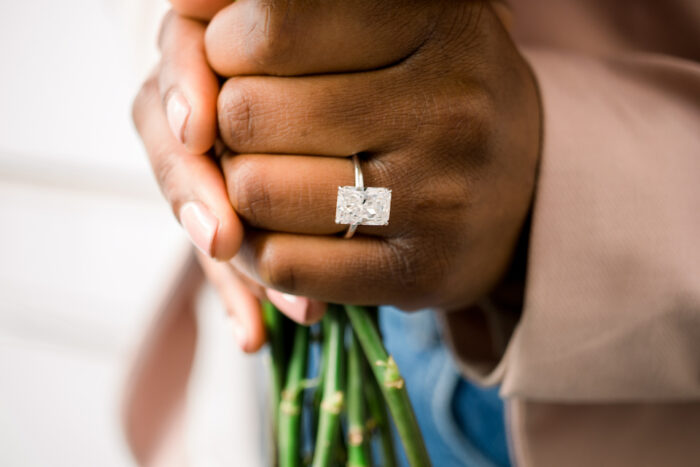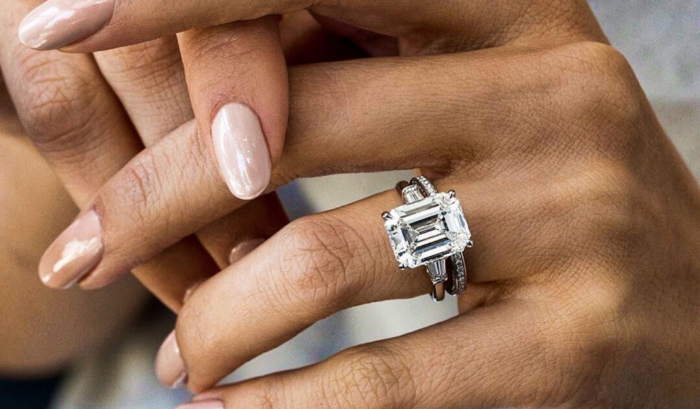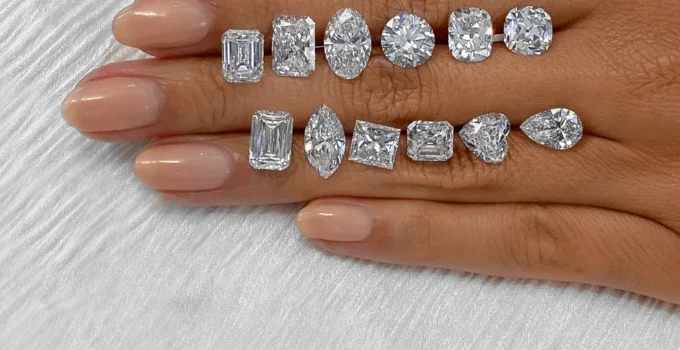Lab-grown diamond rings have emerged as a remarkable trend in the world of fine jewelry, captivating the attention of jewelry enthusiasts worldwide. These exquisite creations are not only dazzling but also offer a range of benefits that make them an attractive alternative to natural diamonds. Lab-grown diamonds are synthesized in controlled laboratory environments, mimicking the natural process that occurs beneath the Earth’s surface. In this blog post, we will delve into the science behind lab-grown stones, compare their quality to natural diamonds, explore the cost advantages they offer, and examine the ethical and environmental considerations associated with their production.
Explaining the science behind lab-grown diamonds

Source: theknot.com
Lab grown diamonds uk are cultivated through a process known as Chemical Vapor Deposition (CVD) or High Pressure-High Temperature (HPHT) synthesis. CVD involves the deposition of carbon atoms onto a diamond seed, while HPHT employs intense pressure and temperature to replicate the natural stone growth. Both methods result in the formation of real diamonds with identical physical and chemical properties to natural ones. They are then carefully cut and polished to bring out their inherent brilliance, ensuring that they possess the same visual allure as their mined counterparts.
Comparing lab-grown diamonds to natural diamonds in terms of quality
When it comes to quality, they are virtually indistinguishable from natural diamonds. They exhibit the same hardness, brilliance, and fire, making them equally captivating. The Gemological Institute of America (GIA), a renowned authority in gemstone grading, even certifies them, further validating their authenticity and quality. In fact, many experts argue that they often surpass natural gems in terms of clarity and color consistency, as they are created under controlled conditions. This consistent quality ensures that lab-grown stone rings are exquisite pieces of jewelry that can rival their natural counterparts.
Cost advantages of lab-grown diamond rings
 One of the significant advantages is their affordability. Compared to natural gems, they can cost up to 30% less, making them an accessible option for individuals looking to invest in fine jewelry without breaking the bank. The cost savings stem from the streamlined production process and the elimination of mining-related expenses. This affordability allows customers to opt for larger or more intricate designs, expanding their choices and enabling them to find the perfect one that suits their preferences and budget.
One of the significant advantages is their affordability. Compared to natural gems, they can cost up to 30% less, making them an accessible option for individuals looking to invest in fine jewelry without breaking the bank. The cost savings stem from the streamlined production process and the elimination of mining-related expenses. This affordability allows customers to opt for larger or more intricate designs, expanding their choices and enabling them to find the perfect one that suits their preferences and budget.
Ethical and environmental considerations of lab-grown diamonds
The ethical and environmental implications are substantial. Unlike natural diamonds, which often have a complex supply chain with potential issues such as conflict or blood stones, they are free from such concerns. They are ethically sourced and do not contribute to environmental degradation caused by mining activities. By choosing them, consumers can ensure that their purchase aligns with their values and supports sustainable practices, contributing to a more responsible and conscientious jewelry industry.
Celebrity endorsement and acceptance of lab-grown diamonds
 They have gained widespread acceptance, with numerous celebrities embracing them. A growing number of well-known figures have chosen lab-grown gem rings for engagements, red-carpet events, and everyday wear, showcasing their allure and desirability. Celebrities like Emma Watson and Leonardo DiCaprio have been vocal about their support for them, emphasizing their environmental benefits and ethical appeal. This endorsement from influential personalities has played a pivotal role in driving the popularity, inspiring a broader audience to consider them as an elegant and responsible choice.
They have gained widespread acceptance, with numerous celebrities embracing them. A growing number of well-known figures have chosen lab-grown gem rings for engagements, red-carpet events, and everyday wear, showcasing their allure and desirability. Celebrities like Emma Watson and Leonardo DiCaprio have been vocal about their support for them, emphasizing their environmental benefits and ethical appeal. This endorsement from influential personalities has played a pivotal role in driving the popularity, inspiring a broader audience to consider them as an elegant and responsible choice.
Customization options and unique designs are available for lab-grown diamond rings
Another compelling aspect is the vast array of customization options and unique designs known. With them, jewelry designers have the freedom to experiment and create intricate pieces that cater to individual preferences. From classic solitaires to intricate halo settings, they can be tailored to reflect one’s style. The ability to choose from various shapes, sizes, and colors allows customers to curate a truly exceptional piece that resonates with their unique taste and personality.
Lab-grown diamonds as a sustainable choice for eco-conscious consumers
 For eco-conscious consumers, they offer a sustainable alternative to traditional mined stones. By opting for them, individuals can actively contribute to the preservation of natural resources and reduce their carbon footprint. Their production of them requires less energy and water, emits fewer greenhouse gases, and eliminates the need for land excavation. As sustainability continues to gain prominence in consumer decision-making, lab-grown diamond rings are emerging as a conscious choice that combines elegance with environmental responsibility.
For eco-conscious consumers, they offer a sustainable alternative to traditional mined stones. By opting for them, individuals can actively contribute to the preservation of natural resources and reduce their carbon footprint. Their production of them requires less energy and water, emits fewer greenhouse gases, and eliminates the need for land excavation. As sustainability continues to gain prominence in consumer decision-making, lab-grown diamond rings are emerging as a conscious choice that combines elegance with environmental responsibility.
Addressing misconceptions about lab-grown diamonds in the market
Despite their increasing popularity, they still face misconceptions in the market. Some argue that man-made gems lack the emotional and historical significance associated with their natural counterparts. However, it is important to recognize that the sentimental value of a gemstone lies in the love and commitment it represents, regardless of its origin. Additionally, concerns about the depreciation of man-made stones worth are unfounded. As the demand for cultured diamonds grows, their value is expected to stabilize, making them a viable investment choice. By dispelling these misconceptions, individuals can appreciate the beauty, quality, and ethical advantages offered by these sustainable alternatives, allowing them to make informed decisions when selecting their perfect piece of jewelry.
Industry trends and future projections for lab-grown diamond rings

Source: rockher.com
The future looks promising for lab-grown gem rings. The industry has witnessed significant growth, with increasing consumer demand and expanding production capabilities. As technology advances, they are expected to become even more affordable and readily available. Furthermore, innovative techniques may allow for the creation of larger and rarer lab-grown diamonds, further broadening the possibilities for stunning jewelry designs. With sustainability and ethical considerations gaining prominence, they are poised to shape the future of the fine jewelry industry.
Conclusion
Lab-grown diamond rings have emerged as a captivating and responsible choice in the world of fine jewelry. Their scientific origins, comparable quality to natural diamonds, affordability, and ethical production practices make them an appealing option for jewelry enthusiasts. With increasing celebrity endorsements, customization options, and sustainability benefits, lab-grown stone rings are redefining the landscape of fine jewelry. As misconceptions are debunked and consumer preferences shift towards conscious choices, they are set to shine brightly, providing a sustainable and exquisite option for those seeking elegance and ethical responsibility in their jewelry collections.
Table of Content




